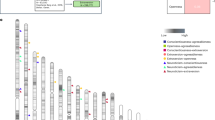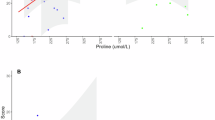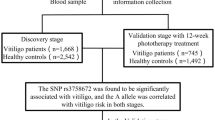Abstract
High neuroticism and low extraversion are characteristic of anxiety-prone individuals. A functional variant in the catechol-O-methyltransferase (COMT) gene, the Val158Met (‘val/met’) polymorphism, has been associated in some prior studies with several phenotypes, including neuroticism. We tested the hypothesis that the val158met polymorphism would be associated with both high neuroticism and low extraversion, making it a plausible candidate locus for anxiety susceptibility. To determine whether val158met is responsible for these effects, we also evaluated the association with haplotypes that included two other SNPs within the COMT gene. We collected a sample of 497 undergraduate college students who were phenotyped on a personality inventory (the NEO-Personality Inventory-Raised (NEO-PI-R)). Subjects were genotyped for three COMT polymorphisms: the well-studied nonsynonymous SNP rs4680 that generates a valine-to-methionine substitution (val158met), rs737865 (near exon #1), and rs165599 (also functional, near the 3′-UTR). Together, these three SNPs define a haplotype that is associated with reduced COMT expression in human brain. Logistic regression analyses were used to examine the effects of individual SNPs on extraversion and neuroticism scores. Score tests for association between these traits (quantitatively and dichotomously considered) and haplotypes were also conducted. We evaluated potential for population stratification artifact by genotyping a set of 36 unlinked highly polymorphic markers previously demonstrated to distinguish sufficiently ancestry of major American populations. Two of the SNPs (rs4680 (‘val/met’) and rs737865) were significantly associated with (low) extraversion and, less consistently, with (high) neuroticism, with effects confined to women. A significant association between COMT haplotype and (low) extraversion and (high) neuroticism was also observed. Formal testing showed that population structure did not explain the findings. These data suggest that involvement of the COMT locus in susceptibility to anxiety-related traits (ie low extraversion and high neuroticism) is unlikely to be wholly accounted for by the well-studied rs4680 (‘val/met’) polymorphism. Other functional variants may exist that contribute to this relationship. Possible sex-specific effects remain to be further studied and explained.
Similar content being viewed by others
Log in or create a free account to read this content
Gain free access to this article, as well as selected content from this journal and more on nature.com
or
References
Akil M, Kolachana BS, Rothmond DA, Hyde TM, Weinberger DR, Kleinman JE (2003). Catechol-O-methyltransferase genotype and dopamine regulation in the human brain. J Neurosci 23: 2008–2013.
Andrews G, Slade T, Issakidis C (2002). Deconstructing current comorbidity: data from the Australian National Survey of Mental Health and Well-Being. Br J Psychiatry 181: 306–314.
Azzam A, Mathews CA (2003). Meta-analysis of the association between the catecholamine-O-methyl-transferase gene and obsessive–compulsive disorder. Am J Med Genet 123B: 64–69.
Bienvenu OJ, Nestadt G, Samuels JF, Howard WT, Costa Jr PT, Eaton WW (2001). Phobic, panic, and major depressive disorders and the five-factor model of personality. J Nerv Ment Dis 189: 154–161.
Bienvenu OJ, Stein MB (2003). Personality and anxiety disorders: a review. J Pers Disord 17: 139–151.
Bilder RM, Volavka J, Lachman HM, Grace AA (2004). The catechol-O-methyltransferase polymorphism: relations to the tonic-phasic dopamine hypothesis and neuropsychiatric phenotypes. Neuropsychopharmacology 29: 1943–1961.
Bray NJ, Buckland PR, Williams NM, Williams HJ, Norton N, Owen MJ et al (2003). A haplotype implicated in schizophrenia susceptibility is associated with reduced COMT expression in human brain. Am J Hum Genet 73: 152–161.
Burchard EG, Ziv E, Coyle N, Gomez SL, Tang H, Karter AJ et al (2003). The importance of race and ethnic background in biomedical research and clinical practice. N Engl J Med 348: 1170–1175.
Chen J, Lipska BK, Halim N, Ma QD, Matsumoto M, Melhem S et al (2004a). Functional analysis of genetic variation in catechol-O-methyltransferase (COMT): effects on mRNA, protein, and enzyme activity in postmortem human brain. Am J Hum Genet 75: 807–821.
Chen X, Wang X, O'Neill AF, Walsh D, Kendler KS (2004b). Variants in the catechol-o-methyltransferase (COMT) gene are associated with schizophrenia in Irish high-density families. Mol Psychiatry 9: 962–967.
Colhoun HM, McKeigue PM, Smith GD (2003). Problems of reporting genetic associations with complex outcomes. Lancet 361: 865–872.
Costa Jr PT, McCrae RR (1992). NEO PI-R Professional Manual. Psychological Assessment Resources, Inc.: Odessa, FL.
Domschke K, Freitag CM, Kuhlenbumer G, Schirmacher A, Sand P, Nyhuis P et al (2004). Association of the functional V158M catechol-O-methyl-transferase polymorphism with panic disorder in women. Int J Neuropsychopharmacol 7: 1–6.
Eley TC, Tahir E, Angleitner A, Harriss K, McClay J, Plomin R et al (2003). Association analysis of MAOA and COMT with neuroticism assessed by peers. Am J Med Genet 120B: 90–96.
Enoch MA, Xu K, Ferro E, Harris CR, Goldman D (2003). Genetic origins of anxiety in women: a role for a functional catechol-O-methyltransferase polymorphism. Psychiatr Genet 13: 33–41.
Fallin D, Cohen A, Essioux L, Chumakov I, Blumenfeld M, Cohen D et al (2001). Genetic analysis of case/control data using estimated haplotype frequencies: application to APOE locus variation and Alzheimer's disease. Genome Res 11: 143–151.
Freedman ML, Reich D, Penney KL, McDonald GJ, Mignault AA, Patterson N et al (2004). Assessing the impact of population stratification on genetic association studies. Nat Genet 36: 388–393.
Fullerton J, Cubin M, Tiwari H, Wang C, Bomhra A, Davidson S et al (2003). Linkage analysis of extremely discordant and concordant sibling pairs identifies quantitative-trait loci that influence variation in the human personality trait neuroticism. Am J Hum Genet 72: 879–890.
Glatt SJ, Faraone SV, Tsuang MT (2003). Association between a functional catechol o-methyltransferase gene polymorphism and schizophrenia: meta-analysis of case–control and family-based studies. Am J Psychiatry 160: 469–476.
Goldberg TE, Egan MF, Gscheidle T, Coppola R, Weickert T, Kolachana BS et al (2003). Executive subprocesses in working memory: relationship to catechol-O-methyltransferase Val158Met genotype and schizophrenia. Arch Gen Psychiatry 60: 889–896.
Hamilton SP, Slager SL, Heiman GA, Deng Z, Haghighi F, Klein DF et al (2002). Evidence for a susceptibility locus for panic disorder near the catechol-O-methyltransferase gene on chromosome 22. Biol Psychiatry 51: 591–601.
Handoko HY, Nyholt DR, Hayward NK, Nertney DA, Hannah DE, Windus LC et al (2004). Separate and interacting effects within the catechol-O-methyltransferase (COMT) are associated with schizophrenia. Mol Psychiatry [Epub ahead of print].
Henderson AS, Korten AE, Jorm AF, Jacomb PA, Christensen H, Rodgers B et al (2000). COMT and DRD3 polymorphisms, environmental exposures, and personality traits related to common mental disorders. Am J Med Genet 96: 102–107.
Hirschfeld RM, Klerman GL, Lavori P, Keller MB, Griffith P, Coryell W (1989). Premorbid personality assesssments of first onset of major depression. Arch Gen Psychiatry 46: 345–350.
Hirschhorn JN, Lohmueller K, Byrne E, Hirschhorn K (2002). A comprehensive review of genetic association studies. Genet Med 4: 45–61.
Huotari M, Gogos JA, Karayiorgou M, Koponen O, Forsberg M, Raasmaja A et al (2002). Brain catecholamine metabolism in catechol-O-methyltransferase (COMT)-deficient mice. Eur J Neurosci 15: 246–256.
Ioannidis JP, Trikalinos TA, Ntzani EE, Contopoulos-Ioannidis DG (2003). Genetic associations in large versus small studies: an empirical assessment. Lancet 361: 567–571.
Jang KL, Livesley WJ (1999). Why do measures of normal and disordered personality correlate? A study of genetic comorbidity. J Pers Disord 13: 10–17.
Jang KL, Livesley WJ, Vernon PA (1996). Heritability of the big five personality dimensions and their facets: a twin study. J Pers 64: 577–591.
Jang KL, McCrae RR, Angleitner A, Riemann R, Livesley WJ (1998). Heritability of facet-level traits in a cross-cultural twin sample: support for a hierarchical model of personality. J Pers Soc Psychol 74: 1556–1565.
Jang KL, Vernon PA, Livesley WJ, Stein MB, Wolf H (2001). Intra- and extra-familial influences on alcohol and drug misuse: a twin study of gene–environment correlation. Addiction 96: 1307–1318.
Jorm AF, Henderson AS, Jacomb PA, Christensen H, Korten AE, Rodgers B et al (2000). Association of a functional polymorphism of the monoamine oxidase A gene promoter with personality and psychiatric symptoms. Psychiatr Genet 10: 87–90.
Kendler KS, Gardner CO, Prescott CA (2003). Personality and the experience of environmental adversity. Psychol Med 33: 1193–1202.
Kendler KS, Kuhn J, Prescott CA (2004). The interrelationship of neuroticism, sex, and stressful life events in the prediction of episodes of major depression. Am J Psychiatry 161: 631–636.
Kendler KS, Myers J, Prescott CA (2002). The etiology of phobias: an evaluation of the stress–diathesis model. Arch Gen Psychiatry 59: 242–248.
Lewontin R (1988). On measures of gametic disequilibrium. Genetics 120: 849–852.
Lohmueller KE, Pearce CL, Pike M, Lander ES, Hirschhorn JN (2003). Meta-analysis of genetic association studies supports a contribution of common variants to susceptibility to common disease. Nat Genet 33: 177–182.
Martin ER, Lai EH, Gilbert JR, Rogala AR, Afashari AJ, Riley J et al (2000). SNPing away at complex disease: analysis of single-nucleotide polymorphisms around APOE in Alzheimer disease. Am J Hum Genet 67: 383–394.
Matsumoto M, Weickert CS, Akil M, Lipska BK, Hyde TM, Herman MM et al (2003). Catechol O-methyltransferase mRNA expression in human and rat brain: evidence for a role in cortical neuronal function. Neuroscience 116: 127–137.
McGrath M, Kawachi I, Ascherio A, Colditz GA, Hunter DJ, De Vivo I (2004). Association between catechol-O-methyltransferase and phobic anxiety. Am J Psychiatry 161: 1703–1705.
Millikan RC, Pittman GS, Tse CK, Duell E, Newman B, Savitz D et al (1998). Catechol-O-methyltransferase and breast cancer risk. Carcinogenesis 19: 1943–1947.
Ohara K, Nagai M, Suzuki Y, Ochiai M, Ohara K (1998). No association between anxiety disorders and catechol-O-methylransferase polymorphism. Psychiatry Res 80: 145–148.
Palmatier MA, Pakstis AJ, Speed W, Paschou P, Goldman D, Odunsi A et al (2004). COMT haplotypes suggest P2 promoter region relevance for schizophrenia. Mol Psychiatry 9: 859–870.
Pritchard JK, Rosenberg NA (1999). Use of unlinked genetic markers to detect population stratification in association studies. Am J Hum Genet 65: 220–228.
Pritchard JK, Stephens M, Donnely P (2000). Inference of population structure using multilocus genotype data. Genetics 155: 945–959.
Pulver AE, Nestadt G, Goldberg R, Shprintzen RJ, Lamacz M, Wolyniec PS et al (1994). Psychotic illness in patients diagnosed with velo-cardio-facial syndrome and their relatives. J Nerv Ment Dis 182: 476–478.
Purcell S, Cherny SS, Sham PC (2003). Genetic Power Calculator: design of linkage and association genetic mapping studies of complex traits. Bioinformatics 19: 149–150.
Reif A, Lesch KP (2003). Toward a molecular architecture of personality. Behav Brain Res 139: 1–20.
Roberts RL, Luty SE, Mulder RT, Joyce PR, Kennedy MA (2004). Association between cytochrome P450 2D6 genotype and harm avoidance. Am J Med Genet 127B: 90–93.
Rothman KJ (1990). No adjustments are needed for multiple comparisons. Epidemiology 1: 43–46.
Rujescu D, Giegling I, Gietl A, Hartmann AM, Moller HJ (2003). A functional single nucleotide polymorphism (V158M) in the COMT gene is associated with aggressive personality traits. Biol Psychiatry 54: 34–39.
Samochowiec J, Hajduk A, Samochowiec A, Horodnicki J, Stepien G, Grzywacz A et al (2004). Association studies of MAO-A, COMT, and 5-HTT genes polymorphisms in patients with anxiety disorders of the phobic spectrum. Psychiatry Res 128: 21–26.
Saritz DA, Olshan AF (1995). Multiple comparisons and related issues in epidemiologic research. Am J Epidemiol 142: 904–908.
Sasieni PD (1997). From genotypes to genes: doubling the sample size. Biometrics 53: 1253–1261.
Schaid DJ, Rowland CM, Tines DE, Jacobson RM, Poland GA (2002). Score tests for association between traits and haplotypes when linkage phase is ambiguous. Am J Hum Genet 70: 425–434.
Schinka JA, Busch RM, Robichaux-Keene N (2004). A meta-analysis of the association between the serotonin transporter gene polymorphism (5-HTTLPR) and trait anxiety. Mol Psychiatry 9: 197–202.
Seamans JK, Durstewitz D, Christie BR, Stevens CF, Sejnowski TJ (2001a). Dopamine D1/D5 receptor modulation of excitatory synaptic inputs to layer V prefrontal cortex neurons. Proc Natl Acad Sci USA 98: 301–306.
Seamans JK, Gorelova N, Durstewitz D, Yang CR (2001b). Bidirectional dopamine modulation of GABAergic inhibition in prefrontal cortical pyramidal neurons. J Neurosci 21: 3628–3638.
Sen S, Burmeister M, Ghosh D (2004a). Meta-analysis of the association between a serotonin transporter promoter polymorphism (5-HTTLPR) and anxiety-related personality traits. Am J Med Genet 127B: 85–89.
Sen S, Villafuerte S, Nesse R, Stoltenberg SF, Hopcian J, Gleiberman L et al (2004b). Serotonin transporter and GABAA alpha 6 receptor variants are associated with neuroticism. Biol Psychiatry 55: 244–249.
Shifman S, Bronstein M, Sternfeld M, Pisante-Shalom A, Lev-Lehman E, Weizman A et al (2002). A highly significant association between a COMT haplotype and schizophrenia. Am J Hum Genet 71: 1296–1302.
Smith MW, Lautenberger JA, Shin HD, Chretien JP, Shrestha S, Gilbert DA et al (2001). Markers for mapping by admixture linkage disequilibrium in African American and Hispanic populations. Am J Hum Genet 69: 1080–1094.
StataCorp (2003). Stata Statistical Software (Release 8.0). Stata Corporation: College Station, TX.
Stein MB, Bienvenu OJ (2004). Diagnostic classification of anxiety disorders: DSM-V and beyond. In: Charney DS, Nestler EJ (eds). The Neurobiology of Mental Illness, 2nd edn. Oxford University Press: New York, NY. pp 525–534.
Stein MB, Chavira DA, Jang KL (2001). Bringing up bashful baby: developmental pathways to social phobia. Psychiatr Clin N Am 24: 661–675.
Stein MB, Schork NJ, Gelernter J (2004). A polymorphism of the b1-adrenergic receptor is associated with low extraversion. Biol Psychiatry 56: 217–224.
Sullivan PF, Eaves LJ, Kendler KS, Neale MC (2001). Genetic case–control association studies in neuropsychiatry. Arch Gen Psychiatry 58: 1015–1024.
Tang H, Quertermous T, Rodriguez B, Kardia SL, Zhu X, Brown A et al (2005). Genetic structure, self-identified race/ethnicity, and confounding in case–control association studies. Am J Hum Genet 76: 268–275.
Van Gestel S, Van Broeckhoven C (2003). Genetics of personality: are we making progress? Mol Psychiatry 8: 840–852.
Winterer G, Goldman D (2003). Genetics of human prefrontal function. Brain Res Brain Res Rev 43: 134–163.
Woo JM, Yoon KS, Choi YH, Oh KS, Lee YS, Yu BH (2004). The association between panic disorder and the L/L genotype of catechol-O-methyltransferase. J Psychiatr Res 38: 365–370.
Woo JM, Yoon KS, Yu BH (2002). Catechol O-methyltransferase genetic polymorphism in panic disorder. Am J Psychiatry 159: 1785–1787.
Yang BZ, Zhao H, Kranzler HR, Gelernter J (2005). Practical population group assignment with selected informative markers Characteristics and properties of Bayesian clustering via STRUCTURE. Genet Epidemiol 28: 302–312.
Acknowledgements
We are grateful to Shadha Hami, MA for coordinating the study and providing database management expertise; and to Ann Marie Lacobelle and Greg Kay for excellent technical assistance. This work was supported in part by NIMH Grant MH64122 to MBS and NIAAA Grants AA11330, and NIDA Grants DA12690, DA12849, and DA15105 to JG; and the US Department of Veterans Affairs (the VA Medical Research Program (Merit Review) to JG).
Author information
Authors and Affiliations
Corresponding author
Additional information
CONFLICT OF INTEREST
None of the authors declare any financial or other form of conflict of interest with the content of this manuscript.
Rights and permissions
About this article
Cite this article
Stein, M., Fallin, M., Schork, N. et al. COMT Polymorphisms and Anxiety-Related Personality Traits. Neuropsychopharmacol 30, 2092–2102 (2005). https://doi.org/10.1038/sj.npp.1300787
Received:
Revised:
Accepted:
Published:
Issue date:
DOI: https://doi.org/10.1038/sj.npp.1300787
Keywords
This article is cited by
-
Sex-specific relationships of the infant microbiome and early-childhood behavioral outcomes
Pediatric Research (2022)
-
Neural correlates of reward processing in adults with 22q11 deletion syndrome
Journal of Neurodevelopmental Disorders (2016)
-
Influence of Val108/158Met COMT Gene Polymorphism on the Efficacy of Modified Electroconvulsive Therapy in Patients with Treatment Resistant Depression
Cell Biochemistry and Biophysics (2015)
-
Multilevel impact of the dopamine system on the emotion-potentiated startle reflex
Psychopharmacology (2015)
-
Impact of COMT genotype on serotonin-1A receptor binding investigated with PET
Brain Structure and Function (2014)



